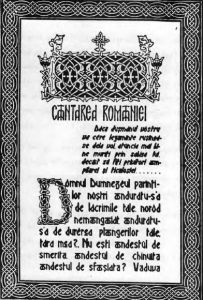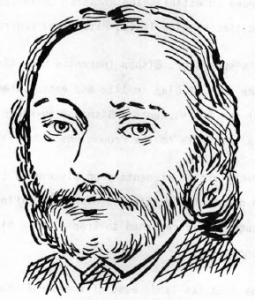Main Body
3. The Romanian Language
The Romanian language is one of the eight Romance languages spoken today: Italian, French, Provencal (which form a linguistic group with the Catalan), Spanish, Portugese, the Romansh (which is spoken in the Engadine and Graubuenden regions of Switzerland), and the Friulan of northeastern Italy between Venice, Trieste and the Dolomites.
Despite foreign rule and invasions which deprived them of basic cultural privileges, and although the Romanians have been surrounded by Slavs and Hungarians for centuries, the Romanian language preserved its Latin origin. Romanian philologists point out that the Latin origin of the Romanian language is also demonstrated by the fact that “Romania,” the name of the nation, came from “Romanus,” as the Roman colonizers of Dacia were known.
Transylvania was under Magyar domination for 900 years; Bucovina was ruled by Austria for 200 years; Bessarabia was controlled by Russia; the old Wallachian and Moldavian principalities were dominated by the Turks and Greeks for 400 years. Each ruling foreign power tried to impose its language and culture on the Romanians, but the Romanians’ fundamental Latin-origin language emerged practically intact.
When all the major Romanian territories finally were united into one Greater Romania in 1918, the Romanians from all provinces who lived apart from each other for centuries, could and did understand and speak Romanian without the slightest difficulty.
The Romanian language consists of three principal categories: the Daco-Romanian, spoken north of the Danube; the Istrian Romanian, spoken along the Adriatic Sea and the Macedonian Romanian, spoken south of the Danube, principally in Serbia, Albania, Bulgaria and northern Greece.
The language spoken north of the Danube is considered by Romanians as their basic literary language. The original common territory from which all categories of the Romanian language branched out is said to have been in Transylvania, the ancient Dacia.
As the result of invasions by various peoples, including Bulgarians and Magyars in the 7th, 8th, 9th and 10th centuries, the Romanian language acquired some non-Latin elements. For centuries the educated Romanians used the old Slavonic and Greek languages in churches and public offices, but the language of the ordinary Romanians not only preserved its Latin origin but, in time, completely eliminated the Slavonic and Greek tongues from the Romanian scene.
The Latin alphabet is believed to have been used for a considerable time before it gave way to the Slavonic, or the Cyrillic alphabet which was probably invented by followers of Sts. Cyril and Methodius in the late 9th century.
Even after the Slavonic language was introduced among the Romanians, the Latin language continued to be used by various Romanian rulers. Throughout the centuries many documents were signed in the Latin language.
In the religious services many of the words used are Latin, which dates back to the christianization of Dacia during the third and fourth centuries. Romanian scholars believe that the Slavonic language was introduced into the Romanian churches by the Bulgarians, since the Romanians’ first political contacts were with the Bulgarians.
The Romanian language appears in writing in the middle of the 15th century. The first reference to it was found in 1464 when Polish merchants from Cracow obtained safe conduct letters in the Romanian language.
The Reformation and the missionary zeal of Martin Luther’s Saxon adherents brought the first printing press into Transylvania where the Saxons were the Reformation’s most ardent followers. John Honterus, a Saxon, brought the first printing press to Brasoy (Kronstadt) in 1533. Eleven years later, another printing press was brought to Sibiu (Hermanstadt).
To spread Luther’s doctrine among the Romanians of Transylvania, the Saxons printed a catechism in the Romanian language in 1544. This is believed to have been the first book printed in the Romanian language. Another Romanian language catechism was printed in Brasov in 1559.
It would be incorrect to say that the Reformation brought the Romanian language into Romanian church affairs. It is more correct to say that adherents of the Reformation were the first to take advantage of the printing press.
With the introduction of the printing press in Transylvania, the number of Romanian language books increased slowly but steadily, although all Romanian books were still printed in the Cyrillic alphabet.
Romanian churchmen were quick to follow in the footsteps of the Saxons, with their own works glorifying the Eastern Orthodox religion.
A Romanian deacon, Coresi, a native of Tirgoviste in Muntenia, printed the first book of the Gospels in the Romanian language (Slavonic alphabet) in Brasov in 1561. Metropolitan Simion Stefan of Transylvania made possible the printing of the New Testament in the Romanian language (Slavonic alphabet) in 1648.
On the eastern side of the Carpathian Mountains, Metropolitan Varlaam of Moldova, one of the most important figures in the Romanian Orthodox Church, wrote his famous “Cazanie” which were explanatory notes on the New Testament. His book printed in the Romanian language in Cyrillic letters appeared in 1643.
Rulers and church leaders were responsible for the publication of an increasing number of Romanian language books in the Slavonic alphabet. By 1716 the total number of books printed in the various Romanian provinces was: 73 in the Romanian language but Slavonic alphabet; 41 in the Greek language; two in Greek-Romanian; 39 in Slavonic and 26 in Slavonic-Romanian.

When the Turks conquered Constantinople, many educated and rich Greeks fled to Italy and to the north of the Danube to Muntenia and Moldova. Using bribery and intrigue, these Greeks by 1595 occupied most of the public offices in the two provinces of Romania. Even the Romanian monasteries and their properties were subjected to the Greek church. By 1650 the Greek language was officially introduced in the Romanian church, in addition to the Slavonic.
Beginning with 1711 the Greek rulers, called the “Phanariotes” (because they hailed from the Constantinople suburb of Phanar), occupied the thrones of Moldova and Muntenia, under the suzerainty of the Turkish sultan.
The period between 1711 and 1826 was one of the blackest in the Romanian people’s cultural history. The Greek rulers forcibly eliminated every trace of the Romanian language from the Romanian churches and placed the Greek language in a dominant, exclusive position.
While these tragic things happened in the Romanian lands east of the Carpathians (then under Turkish domination), great events took place in Transylvania, west of the Carpathians.
In 1698 part of the Orthodox church, under the leadership of Metropolitan Athanase, effected a union with Rome not only on religious grounds but also in the hope of acquiring cultural, political and religious rights for the Romanians in Transylvania, who were then ruthlessly oppressed by the Magyars.
The union with Rome may or may not have brought the expected benefits to the Romanians but it is certain that Metropolitan Athanase succeeded in establishing Romanian-Latin schools in the Transylvanian cities of Alba Iulia, Hatzeg and Fagarash.
Athanase’s successor, Bishop Inocentiu Micu-Klein moved his residence to the town of Blaj in 1738 and established a Romanian language school for 200 students. Bishop Micu-Klein was the first to send Romanian students to the Propaganda Fide College in Rome.
These Transylvanian students soon discovered (in the libraries of the Vatican documents) writings proving the Latinity of the Romanian language. They returned to Transylvania highly enthusiastic about their findings.
While the Romanian lands east of the Carpathians were groaning under the political and cultural yoke of the Greek Phanariote rulers, the Romanian students in Transylvania, starting in Blaj, were getting a Romanian language education.
In 1780 two important Romanians appeared in Transylvania: Samuil Micu and George Sincai, both products of the Romanian school in Blaj. After their return from Rome, they authored the first Romanian grammar written in the Latin alphabet. The effect of this was tremendous in all Romanian populated lands.
A Philosophical Society was founded in Transylvania for the purpose of printing scientific and religious books in the Latin alphabet. Contacts were established with Romanians in Bucharest who were still moaning under the cultural yoke of the Greeks.

At this point of Romanian cultural history, George Lazar introduced the Romanian language in the schools of Bucharest in 1816. Until the advent of this Transylvania scholar on the educational stage of Muntenia, east of the Carpathians, the language of instruction in colleges of Bucharest and other Romanian schools was Greek or old Slavonic.
Lazar was born in Avrig, a village near Sibiu in Transylvania. In 1814 he was ordained into the Orthodox priesthood, but in 1816 he went to Bucharest where he took a tutor’s job in a rich Romanian family.
Noting that in Bucharest the language of instruction in Romanian schools was Greek, Lazar made a spirited campaign to make Romanian the official school language. With the help of influential Romanians he succeeded in establishing the Romanian Academy at the College of St. Sava. Lazar’s Romanian language academy was opened with great ceremony in 1818.
In a short time many students, who previously received instruction in the Greek language, turned to Romanian as their language. By the middle of the 19th century the Greek language was practically eliminated from most Romanian schools.
George Lazar returned to his native village in Transylvania in 1822 and died there the following year. In the United States a Detroit Romanian fraternal society bears his name.
The intimate relation that exists between the Latin and Romanian languages is illustrated in the following table.
| ROMANIAN | LATIN | ENGLISH |
| Dumnezeu | Domine Deus | God |
| altar | altar | altar |
| calendar | calendarium | calendar |
| lege | legem | law |
| pacat | peccatum | sin |
| biserica | basilica | church |
| cruce | crux | cross |
| boteza | baptisare | baptize |
| apa | aqua | water |
| cane | canis | dog |
| cal | caballus | horse |
| bou | bos | ox |
| capra | capra | goat |
| porc | porcus | pig |
| graunte | granucia | grain |
| secara | secalis | rye |
| pane | pane | bread |
| ceapa | cepa | onion |
| nepot | nepotem | nephew |
| batrin | betranus | old |
| pagan | paganus | pagan |
| bine | bene | good |
| dinte | dentem | tooth |
| lemn | lignum | wood |
| frunza | frondia | leaf |
| simtire | sentire | feeling |
| dulce | dulcis | sweet |
Of all Latin origin languages, only the Romanian has the article at the end of the word.
